#xenacanthid
Explore tagged Tumblr posts
Text
Did two for now
And I’m working on eohupehsuchus
#paleoart#speculative biology#speculative evolution#spec evo#lmao#art#paleontology#glaucosaurus#edaphodauridae#xenacanthid#barbclabornia#wikipedia#wikimedia commons#poll
4 notes
·
View notes
Text





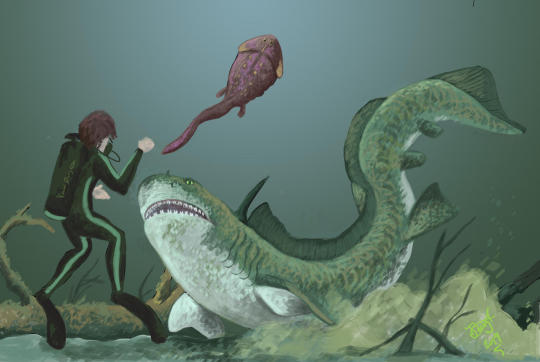

Orthacanthus is an extinct genus of fresh-water xenacanthid shark which lived throughout the rivers, swamps, lakes, and bayous of what is now Eurasia and North America during the Emsian of the early Devonian to the Carnian of the Late Triassic some 407 to 227 million years ago. The first remains of orthacanthus consisting of several neural spines and vertebrae were unearthed from carboniferous rocks in Great Britain by Dr. Louis Agassiz in 1836 which he described as a species of primitive skate. Several more spines and teeth would be found throughout England, Scotland, Wales, Ireland, Nova Scotia Canada, and Ohio USA but were variously assigned to Pleuracanthus and Diplodus. In 1848 a well preserved full body impression of an animal was unearthed near Ruppelsdorf Germany by Dr. Goldfuss who described and named the specimen as Xenacanthus. However additional findings in texas of both Orthacanthus and xenacanthus in the 1880s showed a marked distinction in both size and morphology between the two taxa. These prompted additional studies which showed the German impression to be of orthacanthus and that Dittodus, Didymodus, Diplodus to be synoynomous with orthacanthus and that pleuracanthus was already an established genus of beetles as such all previous pleuracathus fossils are now considered orthacanthus. Today 11 species of Orthacanthus are considered valid: O. gibbosus, O. arcuatus, O. buxieri, O. compressus, O. donnelljohnsi, O. gracilis, O. milleri, O. minor, O. platypternus, O. pustulosus, & O. texensis. Reaching upwards of 10ft (3m) in length, Orthacanthus had a number of features that distinguished it from modern sharks including a ribbon like dorsal fin which ran down nearly the entirety of the animals back, and had paired pectoral & pelvic fins and 4 anal fins. A distinctive spine projected from the back of the head which is speculated to have been venomous, perhaps in a similar manner to a sting ray or chimera. As a large aquatic predator Orthacanthus would have fed upon boney fish, placoderms, sharks and other cartilaginous fish, amphibians, aquatic reptiles, synapsids, and various invertebrates. Interestingly orthacanthus seems to have been a highly adaptable organism with smaller and younger individuals living in shallower waters like ponds, rivers, and streams, while larger older individuals dwelled in freshwater lakes, brackish swamps/ deltas, and even coastal waters.
Art by the following creators:
Orthacanthus: Christopher DiPiazza http://prehistoricbeastoftheweek.blogspot.com/2013/08/orthacanthus-prehistoric-animal-of-week.html
Orthacanthus: Connor Moore https://www.artstation.com/artwork/3do4b2
Orthacanthus: Alain Beneteau https://blog.everythingdinosaur.com/blog/_archives/2016/08/11/orthacanthus-was-a-cannibal.html
Orthacanthus and Xenacanthus: EsthervanHulsen https://www.deviantart.com/esthervanhulsen/art/Orthacanthus-and-Xenacanthus-772704178
Diving with Orthacanthus: HodariNundu https://www.deviantart.com/hodarinundu/art/Diving-with-Orthacanthus-798344700
#pleistocene pride#pliestocene pride#extinct#shark week#shark#mesozoic#paleozoic#triassic#carboniferous#devonian#permian#prehistoric#prehistoric shark#orthacanthus#xenacanthus#freshwater#xenacanthid
13 notes
·
View notes
Text

A group of tiny fossilized chondrichthyan teeth of Barbclabornia luedersensis from the Wellington Formation in Waurika, Jefferson County, Oklahoma, United States. The lack of a central cusp distinguishes this species from the contemporary xenacanthid, Orthacanthus. While its teeth are tiny compared to contemporaries like Orthacanthus, Barbclarbornia is believed to be the largest member of this clade, potentially growing up to 5 meters long. Despite shark-like appearances, xenacanths like Barbclabornia are not true sharks.
#fish#shark#chondrichthyan#fossils#paleontology#palaeontology#paleo#palaeo#barbclabornia#xenacanthida#permian#paleozoic#prehistoric#science#paleoblr#バーブラボルニア#ゼナカントゥス目#サメ#化石#古生物学
41 notes
·
View notes
Text
Xenacanthus
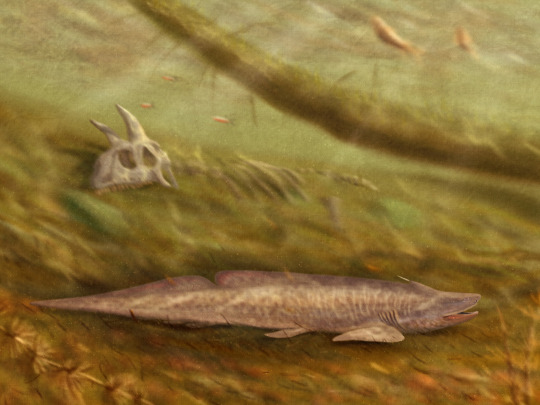
By @stolpergeist
Etymology: Weird spine
First Described By: Beyrich, 1848
Classification: Biota, Archaea, Proteoarchaeota, Asgardarchaeota, Eukaryota, Neokaryota, Scotokaryota, Opimoda, Podiata, Amorphea, Obazoa, Opisthokonta, Holozoa, Filozoa, Choanozoa, Animalia, Eumetazoa, Parahoxozoa, Bilateria, Nephrozoa, Deuterostomia, Chordata, Olfactores, Vertebrata, Craniata, Gnathostomata, Eugnathostomata, Chondrichthyes, Elasmobranchii, Euselachii, Selachimorpha, Xenacanthida, Xenacanthidae
Referred Species: X. atriossis, X. comrpessus, X. decheni, X. denticulatus, X. erectus, X. gibbosus, X. gracilis, X. howsei, X. indicus, X. laevissimus, X. latus, X. ludernensis, X. moorei, X. ossiani, X. ovalis, X. parallelus, X. parvidens, X. ragonhai, X. robustus, X. serratus, X. slaughteri, X. taylori
Status: Extinct
Time and Place: 295 to 208 million years ago, from the Sakmarian of the Early Permian to the Rhaetian of the Late Triassic.

In the Triassic, Xenacanthus is known from New Mexico, Texas, and India.
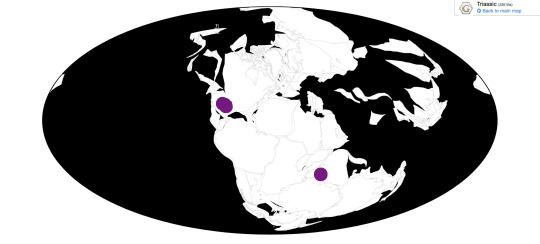
Physical Description: Xenacanthus gets its name from the very large and narrow spike protruding out of the back of its head. Seriously, what’s up with that. Nobody really knows. Besidse that, the thing most people talk about are its teeth. Xenacanthid teeth are distinctively-shaped: they had a large oval base with two prongs shooting out, making the tooth look V-shaped. But beyond this, Xenacanthus is still interesting. The body is long and shallow, with ribbonlike dorsal and caudal fins that form an almost continuous fin going down the back and back up the bottom of the animal. The pectoral and pelvic fins are short and very broad.
Diet: Xenacanthus’s bizarre teeth may hint at a diet of crunchier foods. It likely ate fish and small invertebrates in the waters it lived, as well as potentially the carcasses of anything that drowned.
Behavior: Xenacanthus’s body is not well-equipped for fast swimming. Its pectoral and pelvic fins almost look limblike, and may have potentially been used to help maneuver (or “walk”) around river bottoms like modern epaulette sharks. Xenacanthus likely sat in the muddy bottoms of the rivers it lived in, waiting for prey to swim on by. Although it lived in rivers, Xenacanthus may have migrated to the sea to spawn like its relative Orthacanthus (and some living eels). The purpose of the spike on the back of the head is completely unknown, but it may have been used for display, defense, or stabilizing swimming.
Ecosystem: Xenacanthus lived in shallow freshwater environment such as seasonal rivers. It’s known from two areas in the Triassic: the southwestern United States, and India. In the southwestern US, it lived alongside the lungfish Ceratodus, various ray-finned fish, temnospondyls such as Metoposaurus and Koskinonodon, early dinosaurs like Coelophysis, dinosauromorphs such as Dromomeron, pseudosuchians such as Typothorax, Shuvosaurus, Postosuchus and Poposaurus, phytosaurs such as Rutiodon and Smilosuchus, and various other bizarre archosauromorphs like Vancleavea, Trilophosaurus, and Tanytrachelos. If this sounds familiar, this is because we’ve already featured lots of critters from Late Triassic North America. Lots of familiar faces.
Meanwhile in India, Xenacanthus lived alongside the hybodontid shark Polyacrodus, Ceratodus again, and the temnospondyl Buettneria. These rivers would have been frequented by thirsty amniotes such as the rhynchosaur Hyperodapedon, the protorosaur Malerisaurus, aetosaurs, the early dinosaur Alwalkeria, dicynodonts, the cynodont Exaeretodon, and that weirdo, you know it, you love it, Shringasaurus.
Other: Xenacanthus evolved in the Permian, and amazingly made it through the Great Dying! Sure, they were a lot more common in the Permian, but xenacanthids made it through to the end of the Triassic (when they were apparently done in by the end-Triassic extinction).
~ By Henry Thomas
Sources under the cut
Beck, K.G., Soler-Gijon, R., Carlucci, J.R., Willis, R.E. 2014. Morphology and Histology of Dorsal Spines of the Xenacanthid Shark Orthacanthus platypternus from the Lower Permian of Texas, USA: Palaeobiological and Palaeoenvironmental Implications. Acta Palaeontologica Polonica 61(1): 97-117.
Bhat, M.S. 2015. A new and diverse Late Triassic fish assemblage from India. International Conference on Current Perspectives and Emerging Issues in Gondwana Evolution, Lucknow.
Lucas, S.G., Heckert, A.B., Hotton, N. 2002. The rhynchosaur Hyperodapedon from the Upper Triassic of Wyoming and its global biochronological significance. New Mexico Museum of Natural History and Science Bulletin 21: 149-156.
Palmer, D. 1999. The Marshall Illustrated Encyclopedia of Dinosaurs and Prehistoric Animals. Marshall Publishing, London.
Pauliv, V.E., Dias, E.V., Sedor, F.A., Ribeiro, A.M. 2014. A new Xenacanthiformes shark (Chondrichthyes, Elasmobranchii) from the Late Paleozoic Rio do Rasto Formation (Parana Basin), Southern Brazil. Anais da Academia Brasileira de Ciencias 86(1).
#xenacanthus#xenacanthid#shark#triassic#triassic madness#triassic march madness#prehistoric life#paleontology
160 notes
·
View notes
Photo

On one earth, fish crawled out of the sea. No, not those fish.
The line that would give rise to the sharks and rays also produced the xenacanthids: long, slippery, venemously-spined creatures that hunted the brackish bayous of the late Devonian. This was just when land plants had evolved to the point where they could support an ecosystem of prey. Shark-like predators waited in ambush at the edges of shallow ponds, lunging forward on their front fins to snap up passing invertebrates. These powerful fins were also useful when the pond dried up.
The problem with life on land is that it weighs a creature down. Air does not support flesh the way water does, so a terrestrial animal must evolve a rigid support structure. The xenacanthids did, but not from their flexible, cartilaginous skeleton. Instead, successful land-walkers were those with stronger and larger denticles on their fins. These tooth-like skin structures grew and fused into plates, interlocking aground the legs, fanning out across the chest and groin, and rising to cup the torso. Like their invertebrate prey, the fish evolved exoskeletons.
Imagine the following diversification and extinction events. Terrestrial sharks occupied every niche, from runner to flier to burrower. On one earth, they grew very large.
For this lineage of giant herbivores, eyesight became a problem. Through one evolutionary misadventure or another, these placid browsers could not see well enough to defend themselves from predators. Predators of course took advantage of this sensory deficit, and the most successful grazers were those that cultivated a relationship with sentries.
A species of small flying animal—not in fact anything like a lizard, but a kind of terrestrial shark—lived on the backs of the large browsers. These lizard-birds fed on the parasites that lived between their hosts' armor plates and gill-flaps. And they had excellent vision.
The reader can probably imagine at this point the selective pressures that followed. Predation pressure assured that the tight lines of communication evolved between grazer and flier. Environmental change rewarded those grazers with more complex, cooperative behavior. Larger, more interdependent herds necessitated some means of rapid communication, and there were already these flocks of fliers everywhere.
Flocking behavior is one of the classic examples of emergence.1 Even a simple set of rules enacted by tiny-brained individuals can branch out into impressive feats of calculation on the level of the whole flock. Memories can be kept, strategies can be passed on, events can be simulated in the flock, and the resulting plan enacted to gain real-world prizes. Swarm intelligence, the hive-mind, is known in many Convention species.
This species called itself the Bucolics. The cow-turners.
read on
Picture by Timothy Morris
51 notes
·
View notes
Text

🦈 After about a year of work, I am proud to say that Sharks! : The Meg, The Monsters, and the Myths has finally opened to the public @hmns . 🦈
Us in the paleo-lab have worked so hard on everything from Megalodon teeth to pathological baleen whale jaws to Edestus teeth whorls. One of things I’m most proud of is the Xenacanthid shark dorsal spines from the early Permian of Texas (287-283 MYA) that I, and my colleague Colin Diggins, identified, excavated, and prepared over the last few months. These spines, as well as some teeth, are now on display for everyone to see (so come see them 👀).
What an fantastic way to ring in the summer and I’m proud to have been part of something as cool as this is. My most special thanks to all of my awesome lab volunteers (we couldn’t do it without y’all!) and, of course, Colin, David Temple, and @chuckleah7 . We set up a great team and got some great stuff accomplished. I can’t wait to see what else we’ll do coming up!
9 notes
·
View notes
Text

Eel-sharks were a lineage of freshwater xenacanthid sharks found throughout Gondolend. Though most species were far too small and docile to pose a threat to humans, their sharp teeth and long dorsal barbs could inflict nasty wounds if mishandled.
This little fucker is emblematic of one of the major reasons why I got fed up with my Gondolend project and abandoned it. Rather than work on anything actually important, like writing the damn stories, I just spent years and years flailing around in the weeds creating irrelevant bullshit like this thing that have no purpose except to maybe someday serve as a background prop in a single scene in a story that I may or may not (emphasis on not) write years from now. What's that? Finish the two novellas I've been rewriting and revising for over a decade now? Get started on the huge epic novel duology that those novellas are leading towards? Fuck that, I have to make up a freshwater shark native to a country that none of my current or planned stories are even fucking set in!
I'll still probably reuse it for my current dinopunk setting though, since I've already got it. I just won't even think about creating any more until I've got the damn novel written.
#sharks#fish#speculative evolution#speculative biology#speculative zoology#worldbuilding#my art#dinopunk
3 notes
·
View notes
Photo

(I will probably do more with these pipe-necked weirdos at a later date.)
Transcript for the text on the image under the cut:
PAGE 1
Spectember 2020 #14 | nixillustration.com | alphynix.tumblr.com Concept suggested by: Jesse Sosa & anonymous
Land Sharks
(Selachipoda)
[Image: an early shark with a tapering eel-like body plan and four flipper-like fins. Its dorsal fin is ribbonlike, forming a continuous low fin along its back and tail. There's a long pointed spine on the back of its head.] Xenacanthus-like ancestral form
In a different version of the Late Devonian, sarcopterygians never made their way onto land – but instead at the dawn of the Carboniferous a lineage of early sharks took that evolutionary leap.
The xenacanthids were a group of small freshwater sharks with eel-like bodies and distinctive spines on the back of their heads. Some of them developed the ability to “walk” with their fins in a similar manner to modern epaulette sharks, and were able to survive brief crawls onto land to disperse to isolated bodies of water.
Soon this became a more mudskipper-like lifestyle, spending more time on land with stronger jointed fins. Their gill slits became enclosed in an inflatable “balloon” of skin with a single opening at the back, with the gills themselves stiffened against collapsing and able to absorb oxygen from the air as long as they were occasionally re-moistened with gulps of water – the start of something convergent to lungs. The head-spine shifted from a defensive function to a display structure, mobile enough to be raised and lowered to flash brightly-colored fins at each other.
Some descendants of these early land sharks went on to become the caecilian-like SNAPWYRMS, burrowing limbless creatures specialized to hunt small soil invertebrates – but others developed along a more tetrapod-like path.
Already using internal fertilization and giving live birth to fully-developed young, SHARKAPODS weren’t reproductively tied to the water like early tetrapods were in our timeline. Their neck-lungs became larger and more sophisticated, able to function in the increasingly drying climate of the Late Carboniferous. Now housed in rigid bulbous horn-like structures, their breathing used a unidirectional airflow system, pumping air in from the spiracles behind their eyes and exhaling it from the vents at the back.
While superficially lizard-like in shape, their leg joints didn’t bend in quite the same way, giving them a somewhat awkward gait resembling that of a tortoise.
But their cartilaginous skeletons couldn’t support much weight on land, and so they weren’t able to grow particularly large at first, generally remaining similarly-sized to their ancestors at only about 1m long (3’3”). The most successful Paleozoic lineage of sharkapods, the SHELLSHARKS, solved this problem by instead developing an exoskeleton-like carapace from fused dermal denticles, forming stronger stiffer supports for their bodies and allowing them to grow several times bigger.
[Image: a descendant of the eel-like shark. It's a mudskipper-like or amphibian-like animal, with four proto-legs, bulging gill pouches, and a colorful display fin supported by the spine on its head.] The transitional stem-sharkapod Vexillispinus ambulopterygius
PAGE 2
[Image: a descendant of the mudskipper-like shark, a worm-like animal with a long limbless body. A close-up view shows it head, with tiny vestigial eyes and its toothy jaws extended out like a goblin shark.] Snapwyrms like Harpavermis gaphilus had long snake-like bodies and only vestigial eyes, detecting subterranean invertebrates with electroreceptors in their snouts. Their gills were reduced and most of their respiration took place through their moist naked skin. Extending jaws with a slingshot-like motion allowed snapwyrms to rapidly snag their prey.
[Image: an armored sharkapod, a vaguely lizard-shaped animal covered in in armadillo-like carapace, with its limbs supported by an exoskeleton and serrated edges to its stumpy "feet". Its head is still shark-like, and it has a small colorful "flag" fin on its head and bulbous "lunghorns" on the sides of its neck.] Edaphoselachus sosai, a basal shellshark Large pointed denticles on the ends of shellsharks' limbs act like claws for traction.
Early shellsharks were still small carnivores or insectivores, and were not apex predators. Although their extensive carapaces proved useful to bear more weight and grow larger, the solid structure initially evolved as protection against the main predators in their ecosystems – huge arthropods such as griffinflies.
Later members of the group began to experiment with omnivorous and herbivorous niches, and by the Permian had become the largest terrestrial vertebrates of the Paleozoic. One of the very biggest species was Testudosquama avignatha, a 3m long (9'10") herbivore with a voluminous plant-fermenting digestive system.
Sharkapods' nostrils were blind holes and weren't involved in breathing at all, instead using a bellows-like mechanism to actively pull in air for their sense of smell. In some species their snouts became quite bulbous, housing increasingly complex and sensitive nasal systems.
While both their lunghorns and nasal chambers were sometimes used to produce loud resonating sounds, most Paleozoic sharkapods' hearing was poor, only able to hear low-frequency sounds in air and detecting them as much through ground-based vibration as with their under-developed internal ears. Visual communication was still prevalent, with the ancestral mobile flag-fins being retained on most species.
Extendable jaws remained a characteristic feature of sharkapods, swinging forwards to grab at food and then pulling it back into their mouths – although they were unable to chew and each bite had to be swallowed whole. Some of the herbivorous forms even fused their teeth into hard beaks to snip up tough vegetation.
[Image: a large armored shellshark with a vaguely tortoise-like body plan and a vivid black-and-orange color scheme. It has a bulbous snout, large lunghorns, a small flag-fin and a spiny tail. A close-up view of its head shows its beaked jaws extending.] The giant shellshark Testudosquama avignatha
#spectember 2020#spectember#speculative evolution#specevo#land sharks#sharkapods#pipe necked weirdos#science illustration#art#not paleoart
465 notes
·
View notes
Text
Alwalkeria maleriensis

By José Carlos Cortés
Etymology: For Alick Walker
First Described By: Chatterjee, 1987
Classification: Dinosauromorpha, Dinosauriformes, Dracohors, Dinosauria, Saurischia
Status: Extinct
Time and Place: Alwalkeria lived about 228 million years ago, in the Carnian age of the Late Triassic


Alwalkeria is known from the Lower member of the Maleri Formation of Andhra Pradesh, India

Physical Description: Alwalkeria is one of the earliest known dinosaurs, so it - like other early dinosaurs - showcases the basic dinosaur body plan: small bipedal runner. It had teeth and a skull very similar to its close cousin, Eoraptor, which had slightly different shapes depending on the position within the jaw and a somewhat small, elongate head. It had straight, slender front teeth, and backwards curved teeth in the back of the jaw, with no serrations. Little more is known about its external appearance, given the lack of remains; however, it probably would have had a long tail, short neck, and long legs and arms. Alwalkeria would probably have been only about a meter long, making it one of the smaller dinosaurs known.
Given its small size and early position on the dinosaur tree, Alwalkeria would most likely have been covered in very primitive protofeathers, but without further fossil evidence this cannot be said for certain.
Diet: Alwalkeria has teeth adapted both for feeding on meat and for feeding on plants, so it was probably an omnivore with a highly variable diet.
Behavior: Alwalkeria would have been a fairly skittish sort of animal, as early dinosaurs such as it were not very big nor very common in their ecosystems. As such, it would have used speed to get away from predators, of which there were many. It would have been curious, as well, due to being an omnivore, and a generalist one at that - so more of an opportunist than anything, looking for sources of food wherever it could.

By Ashley Patch
Since it was a dinosaur, like other dinosaurs it would have been a fairly active animal, with a warm-blooded metabolism. It also probably took care of its young.
Ecosystem: Alwalkeria lived near a large lake environment, with mainly ferns present in the region, but also some conifers and horsetails. In the Lower Maleri environment, Alwalkeria lived alongside many other kinds of animals, though no other dinosaurs have been definitively named - only one possible prosauropod. Instead, there were the Cynodonts Exaeretodon, the Phytosaur Parasuchus, the Rhynchosaur Hyperodapedon, the Protorosaur Malerisaurus, the large temnospondyl amphibian Koskinodon, the lungfish Ceratodus, and the freshwater shark Xenacanthus. There may have also been an aetosaur of some sort. Alwalkeria probably mainly fed on small animals such as insects and reptiles not yet found in the fossil record, and it probably mainly had to look out for Koskinodon and Parasuchus in terms of predators.
Other: The original fossils described as Alwalkeria are actually a chimera, with many parts assigned to the genus actually belonging to some sort of early crocodile relative. However, there is an early dinosaur in there too, and that dinosaur seems to primarily resemble Eoraptor, though it hasn’t been thoroughly studied in a phylogenetic analysis. So, that’s what we call Alwalkeria now, even though originally there was more considered to be preserved.
~ By Meig Dickson
Sources under the cut
Angolin, F. L. 2017. Estudio de los Dinosauromorpha (Reptilia, Archosauria) de la Formación Chañares (Triásico Superior), Provincia de la Rioja, Argentina. Sus implicancias en el origen de los Dinosaurios. D. Phil. Thesis, Facultad de Ciencias Naturales y Museo.
Bharadwaj, D. C., S. C. Srivastava, B. V. Ramanamurty, N. Jha. 1986. Palynology of Kamthi Formation from Ramagundam-Mantheni Area, Godavari Graben, Andhra Pradesh, India. The Palaeobotanist 35 (3): 318 - 330.
Chatterjee, S. 1974. A rhynchosaur from the Upper Triassic Maleri Formation of India. Philosophical Transactions of the Royal Society of London, Series B, Biological Sciences 267(884):209-261
Chatterjee, S. 1978. A primitive parasuchid (Phytosaur) reptile from the Upper Triassic Maleri Formation of India. Palaeontology 21(1):83-127
Chatterjee, S. 1980. Malerisaurus, A New Eosuchian Reptile from the Late Triassic of India. Philosophical Transactions of the Royal Society of London, Series B 291:163-200
Chatterjee, S. 1982. A new cynodont reptile from the Triassic of India. Journal of Paleontology 56:203-214
Chatterjee, S., B. Creisler. 1994. Alwalkeria (Theropoda) and Morturneria (Plesiosauria), new names for preoccupied Walkeria Chatterjee, 1987 and Turneria Chatterjee and Small, 1989. Journal of Vertebrate Paleontology 14(1):142
Chowdhury, T. R. 1965. A new metoposaurid amphibian from the Upper Triassic Maleri Formation of central India. 250(761):1-52
Jain, S. L. 1980. Freshwater xenacanthid (= pleuracanth) shark fossils from the Upper Triassic Maleri Formation, India. 21:39-47
Langer, M. C. 2004. Basal Saurischia. In: Weishampel, D. B., P. Dodson, H. Osmolska (ed.). The Dinosauria (2nd Edition). Berkeley: University of California Press: 25 - 46.
Lydekker, R. 1885. The Reptilia & Amphibia of the Maleria & Denwa Groups. 1(5):1-38
Holtz, T. R., L. V. Rey. 2007. Dinosaurs: the most complete, up-to-date encyclopedia for dinosaur lovers of all ages. New York: Random House.
Remes, K., O. W. M. Rauhut. 2005. The oldest Indian Dinosaur Alwalkeria maleriensis Chatterjee revised: a chimera including remains of a basal Saurischian. In Kellner,A. W. A., D. D. R. Henriques, T. Rodrigues (ed.). II Congresso Latino-Americano de Paleontologia de Vertebrados, Boletim de Resumos. Museo Nacional, Rio de Janeiro. 218.
#alwalkeria#alwalkeria maleriensis#dinosaur#saurischian#palaeoblr#omnivore#Mesozoic Monday#India and Madagascar#Triassic#prehistoric life#paleontology#prehistory#factfile#dinosaurs#biology#a dinosaur a day#a-dinosaur-a-day#dinosaur of the day#dinosaur-of-the-day#science#nature
253 notes
·
View notes
Photo

The cladogram for the species mentioned in...I’d say the first 2/3rds or so of Fellow Tetrapod.
In order to appearance we have:
Humans (hominins)
Monumentals (stem-archaeocetes)
Tensors (Von Neuman Machines originally made by therapod dinosaurs)
Adventurians (anomodont therapsids)
Catenaries (salpid tunicates)
Sucessors (rotifers)
Cellendians (onychophores)
Parturians (bucerotid birds)
Quotidians (rotifers)
Translator bugs (lobopods)
Proskelisks (nudibranchs)
Sophronisters (xenacanthid sharks)
Pick (corvid birds)
Neurospastics (deinopid spiders)
Bucolics (xenacanthid sharks)
Greaves (procyonid carnivorans)
Loxodromes (desmodontine bats)
Metruians (octopods)
Strophinxes (placoderm fishes)
Multiplex (biofilms)
Propinquines (temnospondyls)
Vitrifers (scyphozoans)
Toxoplasmotics (stem-sciuromorphs)
Extrusians (myxinoid fishes)
Pneumaticons (phaeophyceaen brown algae)
Roridum (roridulacean bushes)
Sprocket (equisetid horsetail spores)
18 notes
·
View notes
Text
Gigatitan

By Ripley Cook
Etymology: Large titan
First Described By: Sharov, 1968
Classification: Biota, Archaea, Proteoarchaeota, Asgardarchaeota, Eukaryota, Neokaryota, Scotokaryota Opimoda, Podiata, Amorphea, Obazoa, Opisthokonta, Holozoa, Filozoa, Choanozoa, Animalia, Eumetazoa, Parahoxozoa, Bilateria, Nephrozoa, Protostomia, Arthropoda, Mandibulata, Pancrustacea, Hexapoda, Insecta, Dicondylia, Pterygota, Metapterygota, Neoptera, Polyneoptera, Anartioptera, Polyorthoptera, Orthopterida, Panorthoptera, Titanoptera, Gigatitanidae
Referred Species: G. extensus, G. magnificus, G. vulgaris
Status: Extinct
Time and Place: 242 to 227 million years ago, from the Ladinian of the Middle Triassic to the Carnian of the Late Triassic.

Gigatitan is known from Kyrgyzstan.
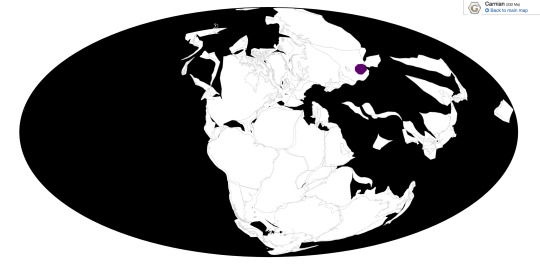
Physical Description: Gigatitan was a very large insect, with a wingspan of 33 centimeters (13 inches). It’s one of the better-known members of Titanoptera, an extinct clade of large predatory insects. It would have looked a little like a giant mayfly, but with a katydid-lke head and much lnger antennae. The forelegs were large and bore sharp spines, similar to those of praying mantises. The wings were large and had distinct fluting. The ovipositor of Gigatitan has sharp ridges, similar to the earlier Carboniferous insect Gerarus.
Diet: Gigatitan was a predator, and its diet potentially included other insects and even small reptiles.
Behavior: It is likely titanopterans had similar lifestyles to modern praying mantises, living as arboreal predators. Their large wings would have allowed them to fly, but their relatively small hindlimbs wouldn’t have allowed them to leap very far. The fluting on the wings could be rubbed by the hindlimbs to produce sound, similar to the chirping of crickets, but if I had to wager, it’d be even more abrasive to the ear. The cutting ridges on the ovipositor were likely used to cut holes in plant material, so that it could lay eggs inside.
Ecosystem: Gigatitan’s fossils were found in the Madygen Formation, which is probably more famous for harboring the bizarre reptiles Longisquama and Sharovipteryx. The Madygen Formation environment was a forested submontane region, with rivers leading out to a large lake. The lowland forests were composed of lycophytes, seed ferns, cycads, gingkos, conifers, and horsetails, with many aquatic plants by the swampy coast. Titanopterans such as Gigatitan preferred the upland regions, which were also home to the cynodont Madysaurus. The environment was flourishing with insects; other insects known include other species of titanopteran, mayflies, cockroaches, hymenopterans, flies, beetles, notopterans, caddisflies, orthopterans, cicadas, and true bugs. The rivers and lakes harbored the amphibian Triassaurus, mollusks, worms, crustaceans, and many fish such as Oshia, Saurichthys, the lungfish Asiatoceratodus, and hybodont and xenacanthid sharks.
Other: Gigatitan is one of the largest insects to have evolved beyond the Carboniferous.
~ By Henry Thomas
Sources under the Cut
Bethoux, O., Galtier, J., Nel, A. (2004). “Earliest Evidence of Insect Endophytic Oviposition”. Palaios 19: 408-413.
Carlton, R.L. (2018). A Concise Dictionary of Paleontology. Springer International Publishing.
Grimaldi, D. (2009). “Fossil Record”. IN: Resh, V.H., Carde, R.T. eds. Encyclopida of Insects. Cambridge Academic Press.
Voigt, S., Spindler, F., FIscher, J., Kogan, I., Buchwitz, M. (2007) “An extraordinary lake basin - the Madygen fossil lagerstaette (Middle to Upper Triassic, Kyrgyzstan, Central Asia)”. Palaontologische Gesellschaft 2007, Freiberg.
#Gigatitan#Insect#Arthropod#Triassic#Palaeoblr#Prehistoric Life#Paleontology#Prehistory#Gigatitan extensus#Gigatitan magnificus#Gigatitan vulgaris#Triassic Madness#Triassic March Madness
374 notes
·
View notes
Text
Ceratodus
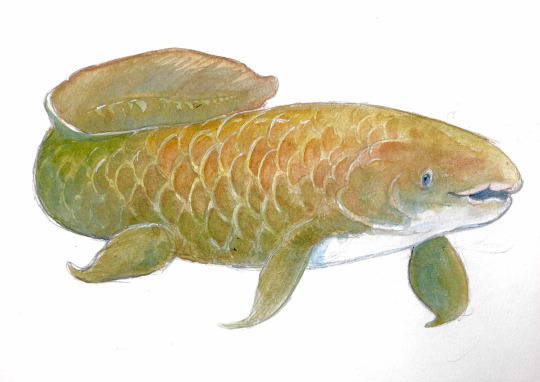
By Ripley Cook
Etymology: Horn tooth
First Described By: Agassiz, 1837
Classification: Biota, Archaea, Proteoarchaeota, Asgardarchaeota, Eukaryota, Neokaryota, Scotokaryota, Opimoda, Podiata, Amorphea, Obazoa, Opisthokonta, Holozoa, Filozoa, Choanozoa, Animalia, Eumetazoa, Parahoxozoa, Bilateria, Nephrozoa, Deuterostomia, Chordata, Olfactores, Vertebrata, Craniata, Gnathostomata, Eugnathostomata, Osteichthyes, Sarcopterygii, Rhipidistia, Dipnoi, Ceratodontiformes, Ceratodontidae
Referred Species: C. africanus, C. carteri, C. diutinus, C. elegans, C. eruciferus, C. felchi, C. fossanovum, C frazieri, C. guentheri, C. gustasoni, C. hierogyphus, C. humei, C. kempae, C. kranzi, C. latissimus, C. molossus, C. nirumbee, C. robustus, C. stewarti, C. szechuanensis, C. texanus, C. tunuensis
Status: Extinct
Time and Place: 252 to 55 million years ago, from the Induan of the Early Triassic to the Ypresian of the Eocene.
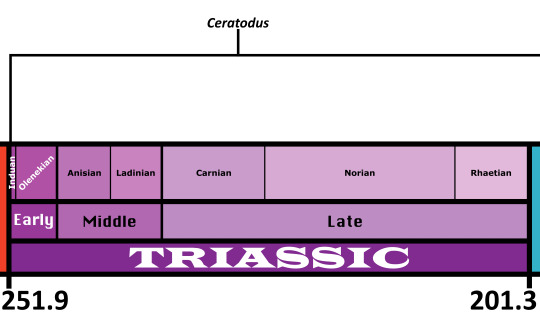
Ceratodus is known from the United States, Peru, Uruguay, Greenland, Svalbard, South Africa, Madagascar, Morocco, Libya, Mali, Niger, Egypt, Sudan, Saudi Arabia, France, Spain, Switzerland, Liechtenstein, Germany, England, Russia, India, Mongolia, Thailand, and Australia.

Physical Description: Ceratodus is... a lungfish. Most of the fossil remains are distinctively-shaped teeth. These teeth are multicusped and in life would be incorporated into a solid crushing surface with other tissues in the mouth. Externally it would have looked very much like the Queensland lungfish. In fact, it used to be considered a species of Ceratodus, until it was moved to the genus Neoceratodus in 1977. Ceratodontiform morphology has changed little in the intervening time. Look at a lungfish and you know what Ceratodus was like.
Diet: Ceratodus would have eaten fish, small amphibians, a variety of invertebrates, and possibly plant matter, much like its living relative.
Behavior: Ceratodus is probably best compared to a fallen log. It would have sat quietly at the bottom of calm waters, waiting for food to come on by. It was likely primarily nocturnal, and more mobile at night. As a lungfish, it would have been able to breathe air, and thus would be able to survive its habitat drying up. Going off its modern relatives, it may have been able to live for absurdly long periods of time if left alone - captive Queensland lungfish can and have reached their 90’s.
Ecosystem: Ceratodus fossils are known from pretty much everywhere. In the Triassic, Ceratodus is known from North America, Europe, western Asia, India, and Australia. Most Ceratodus-bearing habitats were marshlands or other calm freshwater environments. Other Ceratodus-bearing sites are marine, meaning the Ceratodus found there were probably washed out to sea. The seasonal wetlands Ceratodus probably favored were also frequented by sharks such as Hybodus and xenacanthids, ray-finned fish, temnospondyls, and phytosaurs. The exact species vary by location; in North America, Ceratodus lived alongside phytosaurs like Rutiodon and Smilosuchus, while in Eurasia temnospondyls such as Metoposaurus and Cyclotosaurus were more common. Of course, many land-living animals would have come by these rivers to drink, such as cynodonts, rhynchosaurs, pseudosuchians, and early dinosaurs. To go more in-depth would make this article three times as large as it currently is.
Other: There’s a town in Queensland called Ceratodus.
~ By Henry Thomas
Sources under the Cut
Case, E.C. 1921. A new species of Ceratodus from the Upper Triassic of western Texas. Occasional Papers of the Museum of Zoology, University of Michigan 101: 1-4.
Gunther, A.C.L.G. 1871. Description of Ceratodus, a genus of ganoid fishes, recently discovered in rivers of Queensland, Australia. Philosophical Transactions of the Royal Society 161: 511-571.
Kemp, A. 1993. Ceratodus diutinus, a new ceratodont from Cretaceous and Late Oligocene-medial Miocene deposits in Autralia. Journal of Paleontology 67 (5): 883-888.
Martin, M, Ingavat, R. 1982. First record of an upper Triassic ceratodontid (Dipnoi, Ceratodontiformes) in Thailand and its paleogeographical significance. Geobios 15 (1): 111-114.
http://www.paleobiodb.org
#Ceratodus#lungfish#Dipnoi#sarcopterygian#lobe finned fish#Triassic#Triassic madness#triassic march madness#prehistoric life#prehistory#paleontology
237 notes
·
View notes